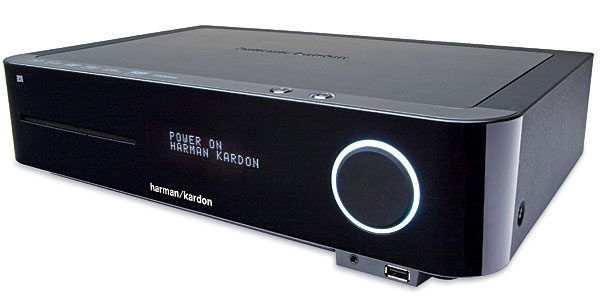Harman Kardon BDS 5 Blu-ray Receiver Page 2
Associated equipment for this review included five Paradigm Reference Studio v.4 speakers and a Paradigm Seismic 110 sub. Since the BDS 5 doesn’t have auto setup, I set the speaker distances manually. Test tones are available in the menu.
 Nearly Instant Gratification
Nearly Instant Gratification
I was happy to find that loading times for all Blu-ray Discs were gratifyingly fast compared with what I’m used to from most players. The first of three I auditioned, all with DTS-HD Master Audio soundtracks, was Tell Tale. In this story of a heart-transplant patient whose new ticker is bent on vengeance, the thumping heart is virtually a leading character in itself. Dialogue was clear, neither edgy nor dumbed down. Vocal timbre was slightly opaque, not as rich or detailed as my experience tells me it would be through a higher-end A/V receiver. But it did avoid the worst excesses of cheap, dirty-sounding digital amps.
Tron: Legacy is the 2010 sequel. Its action-packed soundtrack gave the BDS 5 its toughest workout. I refrained from using the Dynamic Range Control. Instead, I manually adjusted the volume to reconcile dialogue with effects. The first half of the movie needed only slight variations of the BD receiver’s volume range. In the climactic (and most bombastic) scenes, I had to throttle back from the volume control’s 60-percent setting to less than half. The digital amps could energize my speakers to play loudly, but at higher volumes, the system’s resolution clearly waned along with my comfort level.
The Back-up Plan is a romantic comedy with Jennifer Lopez struggling with pregnancy-related relationship issues. The system was slick enough to let me distinguish between the pristinely recorded orchestral soundtrack and the inserted songs, which sounded like most pop music does these days: digitally processed to death.
DVS Sessions
The music demos gave me a chance to reacquaint myself with Dolby Virtual Speaker, which I’ve rarely used in the past. It has two modes: Wide, designed to make the front left/right speakers sound wider than they are; and Reference, which doesn’t attempt width enhancement. Both aim to produce surround-like effects using just two speakers, with no center or surrounds.
This experimentation might have been an injustice to William Lawes, the 17th-century English composer, and Phantasm, the quartet who soulfully performed his Consorts in Six Parts with treble and bass viols. I certainly couldn’t complain about the rich string sound the BDS 5 conjured from the period instruments, abetted by a beautiful Channel Classics recording. The DVS processing brought the soundstage forward a little, although it couldn’t create the fully formed soundfield available in the 5.1channel Dolby Pro Logic II Music mode. The real downside, though, was that it didn’t sound as natural as either the original stereo CD source or DPLII’s 5.1-channel remake.

Keith Jarrett’s Vienna Concert, one of his many forays into spontaneous solo piano, confirmed something I’d already suspected. DVS tampered with decay and ambience, divorcing them from the instrument and thus undercutting the realism of the recording. In this respect, the Reference mode didn’t improve on the Wide mode. This album’s long tracks, one running to nearly 42 minutes of delirious improv, also called my attention to the system’s screen saver. Not only did it suspend the onscreen display, it also mindlessly replaced the input label and the elapsed time counter on the front panel with the words SCREEN SAVER. I went into the setup menu to turn the darned thing off (my LED-backlit LCD set can do without a screen saver). In stereo, the system did as fine a job of reproducing grand piano as it had with the period string ensemble. It made a better impression during the music demos than it had during the movies—probably because its modest digital amp wasn’t being stressed by wide movie dynamics being played in multiple channels simultaneously.
The DVS demos finished with Barrett, Syd Barrett’s second solo album. This acid-casualty document, once unbearably disturbing to my ears, has acquired stature over the years with its ingratiating melodies, stream-of-consciousness words, and gently unraveling psychedelia. In this strange landscape, DVS suddenly made sense, pushing Barrett’s voice forward and emphasizing his humanity. This album had never before seemed so listenable.
The Harman Kardon BDS 5 Blu-ray receiver is clearly a well-designed product that performs well at low to moderate volumes. Its lack of video inputs, network audio features, room correction, and the ability to tune the crossover suggest that it’s not intended for use in a primary home theater system. In a day when you can purchase a separate AVR and even a 3D-capable Blu-ray player for considerably less than the BDS 5’s $799 price, you can’t call it a great value. But if you want to play discs in a small to midsized room at reasonable volume and with a minimum of clutter, this is a small and quite effective onebox solution for you.





























































